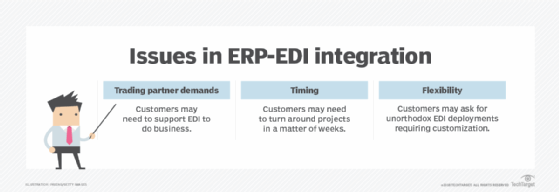
MuleSoft integration tackles EDI supply chain data issues
Salesforce integrates EDI data into its platform for users who deal with many suppliers -- or distributors -- with MuleSoft in an attempt to solve an age-old integration snafu.
With its latest release, Salesforce's MuleSoft division takes on a problem that has vexed B2B-oriented organizations since the 1960s: electronic data interchange integration.
EDI links suppliers with customers to manage orders in a standardized, automated manner -- in theory. That was the idea when the format was introduced. But in reality, each supplier has its own version of EDI data. This means customers must manually aggregate all their different EDI communications into their own common reporting mechanism in a spreadsheet or custom-built integration tools, just to know what is arriving when at their facilities.
It can be a messy and time-consuming process for companies such as manufacturers or hospitals that deal with hundreds of suppliers or more.
Such integrations have the potential to help developers make more efficient the often tedious process of normalizing EDI data to use in their IT stacks, Gartner analyst Max van den Berk said. EDI is inherently messy because it all happens at the edge, with incoming data or created in applications by end users. It takes developer resources to merge it into a central repository and get a composite picture of supply chain activity.
Van den Berk added that he will reserve judgment on it until the market learns more about it, but said Salesforce has a "good story" if it can pull off EDI integration well.
Salesforce also released MuleSoft Accelerator for Salesforce Order Management System, which integrates EDI. OMS manages orders, payment processing, and supplier and shipper communications, among other aspects of order fulfillment, and has been utilized by B2C companies. EDI support is one of several features Salesforce added to MuleSoft to make OMS more B2B-ready.
Also released were MuleSoft Anypoint Partner Manager and Intelligent Document Processing, which can ingest PDFs and images of documents such as invoices and purchase orders. It can monitor supplier transactions and track shipping statuses or orders as information moves through a company's APIs and various applications.

EDI integration and the other tools will open OMS to more B2B users, said Andrew Comstock, vice president of product management at Salesforce. Organizations that deal with a lot of partners or suppliers might be able to slash their onboarding process from months to days -- and get to doing business faster.
Although MuleSoft does the behind-the-scenes "dirty work" of cloud integrations, it has turned into an essential part of enabling Salesforce developers to integrate workflows more efficiently. Eight out of 10 of Salesforce's biggest deals in the most recent quarter, ending Jan. 31, included MuleSoft integration components, Comstock said, which demonstrates its importance to getting new Salesforce instances -- or expansions of existing instances -- up and running in the user's tech stack.
Don Fluckinger is a senior news writer for TechTarget Editorial. He covers customer experience, digital experience management and end-user computing. Got a tip? Email him.








